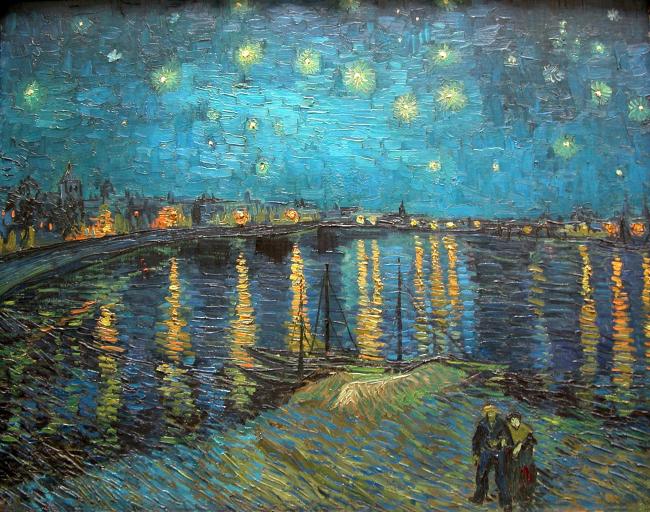Vincent Van Gogh- 1888, Starry Night over the Rhone
People with bipolar disorder are often very fascinating in the early stages.
Before I start writing about this group I would like to give you a clinical description of Bipolar disorder according to the DSM-4 and DSM-5:
Bipolar Disorder (formerly called manic-depressive) affects 1 to 1.5 % of the population. Patients have one or more Manic or nearly manic episodes (extreme elevated mood), alternating with major depressive episodes (extreme sadness). The first episode often occurs in the mid-20s and unfortunately, often leads to suicide.
A manic episode: is defined by a distinct period featuring abnormally and persistently elevated, expansive, or irritable mood, and this period has to last at least one week, of course less if hospital is required.
The mood disturbance has to be accompanied by at least three symptoms: First of all, inflated self-esteem or grandiosity. So a typical incident of this sort would be a bipolar person who buys a house that he can’t afford because he thinks that it is very important to his life and that he is very important in the world. Decreased need for sleep, Pressure of speech, Flight of ideas, distractibility, increased involvement in goal directed activities or psycho-motor agitation, Excessive involvement in pleasurable activities with likelihood of painful consequences
(being involved in unusual sexual activities for example)
It is important to know that these disturbances need to be severe enough to cause impairment in social- or occupational functioning. So it’s not enough to feel good or to feel bad, one’s life needs to be disrupted.
So the impulsive behavior during a manic episode can lead to serious consequences for the person and the family and a major depressive episode can cause the person to be dysfunctional in his or her daily life.
Bipolar disorder has 3 different types:
Bipolar I, This classic type, has pretty fast cycling with very high ups and very high downs.
Bipolar II Manic episodes are not so high (“hypomanic”), not so frequent, depressive episodes are severe.
cyclo-thymia Milder than other two. Less severe mood swings, but persistent and recurring.
Bipoloar disorder, specially the classic type has a high heritability .77 which is even higher than major depression which has a high genetic component. Unfortunately the medications for this disorder have not advanced in the last few decades and a lot around the cause has remained mystery.
Now that you know more about this disorder, let us think about how it is that genes pre-disposing to bi-polar disease have survived and even perhaps maintained their ratio in modern societies? The answer may be that a small disposition to bipolar behavior and manic behavior may be a selective advantage. In fact bipolar people often receive favorable notice for their excellent achievements in high functioning environments such as artistic environments, universities, corporate leaderships and government.
Kay Redfield Jamison, who wrote two amazing books about mood disorder, presented a list of highly creative people, artists, writers, composers, musicians, poets and artists in her books. These people´s success seemed to go along with a certain propensity toward mood, possibly bipolar behavior.
A good example of a person who showed some traits of bipolar disorder would be the painter Van Gogh. He made statements that seem hypomanic such as “I’d like to do portraits which will appear as revelations to people in a hundred years’ time”. In his rather short lifetime, 47 years, he was vastly prolific, with 750 paintings, 1600 drawings and 700 letters. He had a beautiful style of brush strokes that was very typical of his work. He was born and raised in the Netherlands, moved to Paris where many artists lived in, at that period. In Arles he was hospitalized after cutting off his own ear, an obvious manic state and two years later he shot himself.
When most of these artists and writers and composers and poets lived, there was no DSM, there was no clear distinction between neurology and psychiatry and no way to talk about bipolar disease. Also, certainly, no way to distinguish among bipolar 1, 2 or 3. But, this list of highly creative people, artists, writers, composers, musicians, poets, artists is really quite impressive.
Jamison’s list
KEY:
H= Asylum or psychiatric hospital; S= Suicide; SA = Suicide Attempt
Writers Hans Christian Andersen, Honore de Balzac, James Barrie, William Faulkner (H), F. Scott, Fitzgerald (H), Ernest Hemingway (H, S), Hermann Hesse (H, SA), Henrik Ibsen, Henry James, William James, Samuel Clemens (Mark Twain), Joseph Conrad (SA), Charles Dickens, Isak Dinesen (SA), Ralph Waldo Emerson, Herman Melville, Eugene O’Neill (H, SA), Mary Shelley, Robert Louis Stevenson, Leo Tolstoy, Tennessee Williams (H), Mary Wollstonecraft (SA), Virginia Woolf (H, S)
Composers Hector Berlioz (SA), Anton Bruckner (H), George Frederic Handel, Gustav Holst, Charles Ives, Gustav Mahler, Modest Mussorgsky, Sergey Rachmaninoff, Giocchino Rossini, Robert Schumann (H, SA), Alexander Scriabin, Peter Tchaikovsky
Non-classical composers and musicians Irving Berlin (H), Noel Coward, Stephen Foster, Charles Mingus (H), Charles Parker (H, SA), Cole Porter (H)
Poets William Blake, Robert Burns, George Gordon, Lord Byron, Samuel Taylor Coleridge, Hart Crane (S) , Emily Dickinson, T.S. Eliot (H), Oliver Goldsmith, Gerard Manley Hopkins, Victor Hugo, Samuel Johnson, John Keats, Vachel Lindsay (S), James Russell Lowell, Robert Lowell (H), Edna St. Vincent Millay (H), Boris Pasternak (H), Sylvia Plath (H, S), Edgar Allan Poe (SA), Ezra Pound (H), Anne Sexton (H, S), Percy Bysshe Shelley (SA), Alfred, Lord Tennyson, Dylan Thomas, Walt Whitman
Artists Richard Dadd (H), Thomas Eakins, Paul Gauguin (SA), Vincent van Gogh (H, S), Ernst Ludwig Kirchner (H, S), Edward Lear, Michelangelo, Edvard Meunch (H), Georgia O’Keeffe (H), George Romney, Dante Gabriel Rossetti (SA)
suggestions for reading:
Touched with fire by Kay Redfield Jamison
An Unquiet Mind by Kay Redfield Jamison




